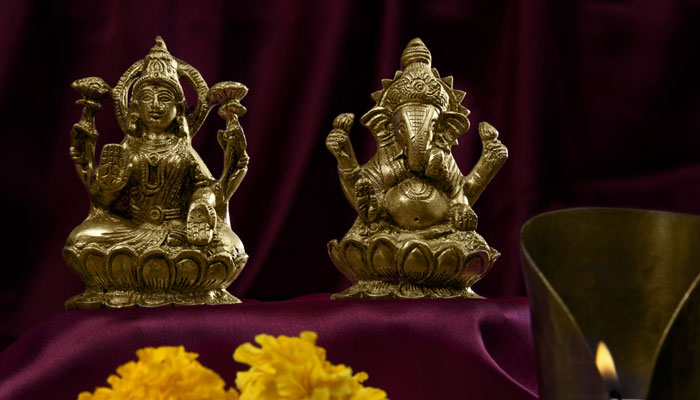 The season has changed, the lights have been lit—smile and dress-up because the festival of lights is knocking on your door. On this festive day, be prepared to please the Hindu goddess of wealth, prosperity, fortune and luxury—Lakshmi.
The season has changed, the lights have been lit—smile and dress-up because the festival of lights is knocking on your door. On this festive day, be prepared to please the Hindu goddess of wealth, prosperity, fortune and luxury—Lakshmi.
Diwali is synonymous with sweets, fire-crackers, gifts and card-playing. Besides these activities, one of the foremost rituals, which is performed in almost every Indian household, is the traditional ‘Lakshmi Puja’, to make the goddess happy. We will tell you how to perform the Lakshmi Puja this Diwali, so that the goddess showers her love on you in the form of prosperity and fortune. Immerse your mind, body and soul to let the divine energy bless you!
The Method to perform the traditional puja:
Firstly, before starting the puja process, a discreet cleaning drive starts. You will have to minutely clean the place where Mata Lakshmi’s ‘aasan’ (elevated place for resting the goddess) will be made. You can use ‘Ganga jal’ too to purify the area, once cleaning is done.
Secondly, what follows is the setting-up of a raised platform. Once, you have decided where to place the goddess, all you need to do is create a raised platform and on it place a red-coloured cloth. In the centre of the cloth, carefully put a handful of grains.
After the sacred place for Maa Lakshmi is made, your next step will be to prepare a ‘kalash’ (pot), which will be placed on the raised platform. Therefore, get started with filling the ‘kalash’ with water, one supari, a marigold flower, coin and rice. You also need to keep five mango leaves, which will be used in the ‘kalash’ (and put inside it, in a fashion that they stand out).
Once the basics are done, you can now get started with the next round of preparations, after which goddess Lakshmi and lord Ganesha will be placed on the ‘kalash’. Now, after the mango leaves are placed inside the ‘kalash’, the next step is to prepare a traditional ‘puja ki thali’, comprising rice grains, which will have to be placed in a heap (not too high). Then, with the help of turmeric powder (also known as ‘haldi’), draw a lotus flower over it. Once your drawing is completed, gracefully place your beautiful Lakshmi idol over it. As is known to all, goddess Lakshmi is our supreme source of livelihood, kindly place some coins before the idol (Maa will feel happy).
According to Hindu mythology, lord Ganesha is invoked before any god or goddess when performing a puja or havan. Therefore, you will also have to place a Ganpati idol on the right side of the ‘kalash’ (making sure that it is the South-West direction). As per rituals in our Hindu religion, welcome the lord with putting a haldi-kumkum tilak on the forehead. Offer some rice grains to the Ganpati idol.
Once the Lakshmi-Ganesha idols are strategically placed, you can also seek the blessings of the god and goddess by keeping your books, pen or any such personal belonging (you feel is related to your profession). With all this done, now is the time to light the lamp.
Light a special Diwali diya, and place it on the ‘puja ki thali’. Also, with it put some more rice grains kumkum and flowers. You will also have to remember to keep aside a glass of water which will be used during the puja. Now, as you proceed to perform the puja—start with putting a ’tilak’ on the ‘kalash’, also apply it on a glass of water which you kept it aside forpuja. Offer some flowers also.
Now starts the process of invoking the goddess. If you know how to correctly chant the vedic mantras of Lakshmi Maa—sing it, if you can’t—worry not. Take some flowers and rice grains in your hand, close your eyes with full devotion bow your head down before the goddess and chant her holy name. Afterwards, offer the flowers and rice in your hand to the goddess.
Once the goddess is invoked, take the Lakshmi idol and put in a plate, while bathing it with water. Put the ‘panchamrit‘, and clean the idol again with pure water. Now, carefully clean the idol, wipe out the water and place it on the ‘kalash’.
Now is your turn to apply haldi-kumkum tilak to the mother goddess, and yes don’t forget the rice grains. Welcome the goddess with a freshly-made garland of flowers. You can also offer some marigold and Bel. To get that aromatic feel, light up some incense sticks before the goddess.
You will then have to please the goddess offering her some sweets, as it is the festival of wonderful mithais. Place the coconut in front of the goddess. You will also have to place the supari on a supari leaf—again beautifying it with some haldi-kumkum and rice grains. Also add some puffed rice, coriander seeds and cumin seeds. What follows is, offering the Mother goddess your favourite Diwali mithai, fruits, money, or any precious jewellery item.
Lastly, the entire puja culminates with a Lakshmi aarti, where everyone joins in the celebratory mood and prays to the Mother goddess together. With folded hands, we immerse ourselves before the goddess Lakshmi and in our honest askings —pray for prosperity and well-being.
‘Let there be light’, the Lord once said—that light was Diwali, did anyone say?
Wish you all a very happy and prosperous Diwali!





